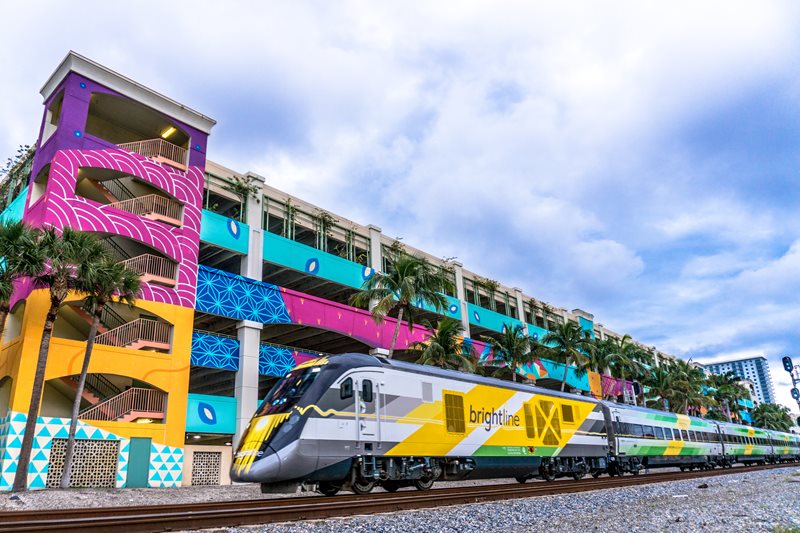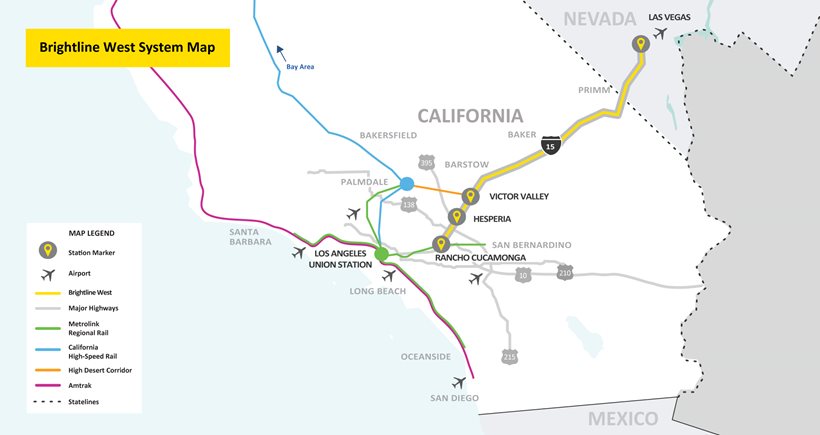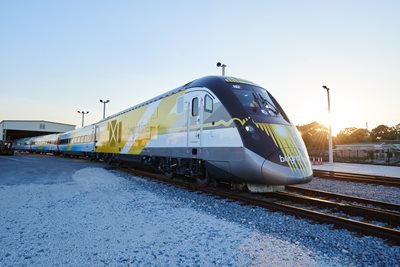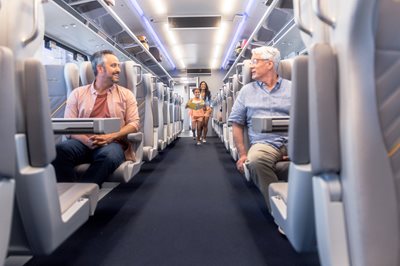
Oct. 27, 2023
A RACE IS underway in California to make two grand visions for new rail systems a reality. The race is not measured in miles per hour; on that count, the competitors are even. It is, instead, measured in years, decades, billions of dollars, and tens of billions of dollars.
One team had a head start. But, at this point, the smart money is on the underdog.
In the mid-2000s, Governor Arnold Schwarzenegger made a suitably muscular pledge: to unite the state’s northern and southern regions through the nation’s first true high-speed rail (HSR) line.
Voters approved $9 billion in bonds in 2008 to contribute to a $33-billion price tag. Today, a right of way has been cleared, and viaducts loom over irrigation ditches and almond groves, but even the line’s initial segment is nowhere near completion. Cost estimates put the total well over $100 billion.
While the dream of connecting Los Angeles with the Bay Area — and enlivening smaller cities along the way — remains tantalizing, California High Speed Rail faces unspeakable challenges. Even in the long, billiard-table flat section through the Central Valley, everything from irate farmers to existing infrastructure have delayed and complicated construction. If the route ever extends beyond the valley, it has formidable mountain ranges to contend with — and even more irate neighbors — on both ends.
“The state was struggling with its own high-speed rail system,” said Orlando Acevedo, assistant town manager of Apple Valley, California. “That framed the perspective that a lot of California and High Desert folks had of high-speed rail in general.”
By comparison, a bullet train to Las Vegas might sound like a novelty, on par with San Francisco’s cable cars and the Disneyland monorail. Except, 50 million car trips are currently taken between the Los Angeles metro area and southern Nevada, in addition to more than 2 million commercial air passengers between Las Vegas and the region’s four airports. Travelers include locals going for a weekend romp, tourists doing circuits of the West, and businesspeople attending the city’s roughly 20,000 annual conferences, conventions, and meetings.
Brightline West believes it can capture up to 11 million of those passengers.
The route from the Los Angeles area to Las Vegas also offers the distinct advantage of having no major mountain ranges, few private land holdings (and nothing on the order of the Central Valley’s mega-farms), and very few people. As drivers well know, the territory between the coast and southern Nevada encompasses one of the most inhospitable deserts on the continent.
All the more reason to want to get past it as quickly as wings, or wheels, will carry you. And, the distance from Las Vegas to Los Angeles, at 275 miles, is just long enough for driving to be painful, but short enough that the hassle of air travel often feels undue.

A SWEET SPOT FOR RAIL
At just over 200 miles, it’s in the sweet spot for HSR, according to Eric Eidlin, research associate at the
Mineta Institute of Transportation at San Jose State University.
Brightline West, which will develop and operate the line, adopted the project after the demise of Desert Xpress, a provocative name evoking Sin City. Founded in the mid-2000s, Desert Xpress went bust in 2015, when the line’s Las Vegas-based developers failed to secure a federal loan (withheld in part because the company could not source its rolling stock domestically).
This time may be different.
“For a really long time the project was ‘see it to believe it.’ Brightline in the past few years…. has demonstrated that they are a savvy, sophisticated, aggressive, experienced group,” said Acevedo, noting the project “continues to gain speed, pun intended.”
Sentiments are similar in Las Vegas.
“Virtually my entire life, we’ve been told that this is something that would happen. And, my whole life, I have yet to see it happen,” said Clark County Commissioner Michael Naft, whose district encompasses Brightline’s intended station. “People are starting to realize that this is really possible and, in my view, really going to happen.”
Though it never laid a single railroad tie, Desert Xpress did receive federal environmental clearance for its route. Brightline acquired Desert Xpress’s clearance and land agreements, and approached the project afresh in 2019 — replete with backing from venture capital firm Fortress Investment Group.
“We’ve done maybe the most difficult steps,” said Ben Porritt, Brightline’s senior vice president for corporate affairs. “Step one is securing our land in all of our right of way, an existing corridor that’s already environmentally disturbed.”
It plans to run a number of trains to be determined daily at top speeds of 186 MPH in relatively luxurious accommodations along the 218-mile route. The company estimates that it can capture 20 percent of those 50 million trips — a percentage that, according to the company, will make its roughly $8 billion capital investment worthwhile.
The company plans to break ground before the end of the year.
BUILDING ON PAST SUCCESS

Brightline West will build on a sister system already operational in Florida. Brightline Florida initially ran from Miami to West Palm Beach. A major northward extension — longer than the current line — to Orlando opened September 22, and a third phase is planned from Orlando International Airport to Tampa. That line, which uses a pre-existing railroad right-of-way, has attracted roughly 2 million annual passengers. Even so, the Florida line travels around 110 MPH, making it an interim step toward true high-speed rail.
“What Florida has provided us is a real use case for everything we need to know about building, operating, marketing, advertising, finding unique ways to introduce people to the concept,” said Porritt. The company’s success in Florida has been crucial for gaining support for the more ambitious project out west.
“We have successfully worked with all the local partners, local electeds, local business communities and shared our vision,” said Porritt. “They’ve gone from optimistic to believers.”
The company hopes that Brightline West will capture the nation’s imagination.
The federal government has been contemplating high speed rail since 1965 but zero miles have been built. Meanwhile, other countries, primarily in western Europe and east Asia, have developed entire national and international networks. Brightline believes that the Los Angeles-Las Vegas route is the ideal test case that could lead to, if not a national network, then at least disjointed lines linking other city pairs and uniting urban regions.
“All of us in this country really envision a nationwide network of city pairs being connected with high-speed rail,” said Porritt. “We want to see what they have in Europe and Asia…. we’ve all wondered for decades why that can’t happen.”
Starting with its terminus on the southern edge of the Las Vegas Strip, the Brightline route will pass relatively unimpeded through 200 miles of desert, in the Interstate 15 highway median for 96 percent of its route. It’s 24 miles to the California border, and then 150 miles to the first of three California station stops, in the High Desert city of Apple Valley (which is not as lush as its name implies).
Apple Valley and its adjacent city, Victorville, may not have many boardings. The station will exist in large part to connect to a hoped-for spur of California High Speed Rail. If built, the spur would bring Brightline passengers to Palmdale and then join the main line through the Central Valley and up to the Bay Area.
“We look at California High Speed Rail as simply a different model to get to the same goal that we have,” said Porritt. “We’ll certainly root for that project and ultimately connect to that project, and we would serve as the east-west and they as the north-south.”
The train will stop in the bedroom community of Hesperia before entering the Cajon Pass. Then things get interesting. A previous iteration of Brightline planned to terminate at Victorville, inviting passengers who originate in Los Angeles to drive roughly halfway to Las Vegas and then ditch their cars. This wildly inconvenient arrangement was envisioned to avoid the Cajon Pass.
Separating the San Gabriel Mountains from the San Bernardino Mountains, the Cajon Pass is one of the major bottlenecks connecting Southern California’s logistics industry with the rest of the continent. Drivers know it as a congested but usually manageable bottleneck. Freight trains know it as one of the steepest, but most important, grades in the entire American rail network, reaching 3 percent.
The company reached an agreement with the California Department of Transportation to develop the Hesperia-Rancho Cucamonga leg in March. That was, arguably, the most important of Brightline’s bureaucratic hurdles. Rancho Cucamonga Assistant City Manager Matt Burris said this leg will allow riders to bypass all of the congestion drivers have to deal with traversing roads through the Cajon Pass.
Brightline is willing to go to the expense and do the engineering to get its train through the Cajon Pass because, once the mountains are breached, roughly 10 million people will live within a 50-mile semicircle. Brightline is betting that, for them, a short drive and the opportunity to let the train do the heavy lifting up through the pass will enable Brightline to hit its ridership projections.
“If it’s not connected to the core of the LA basin, are people really going to drive to this place pretty far out there?” said Mineta’s Eidlin.
Even so, Brightline still faces a nemesis: the 10 Freeway.

Though Brightline West is billed as “Los Angeles to Las Vegas,” its western terminus will be located in Rancho Cucamonga, a suburb about 40 miles east of downtown Los Angeles that sits squarely in the Inland Empire. For many travelers coming from the western part of Los Angeles County (where LAX airport is located), Rancho Cucamonga might as well be Las Vegas itself.
Brightline’s success will depend, in part, on convincing travelers to make their way to Rancho Cucamonga — a trip that could take anywhere from an hour to three hours, depending on traffic — and then to board a train.
Rancho Cucamonga is a lot closer than Victorville, though. It’s also accessible. Three freeways — Interstate 10, California Route 210, and the 15 itself — pass within a few miles of the Brightline station.
“That’s partly why this is an ideal location,” said Rancho Cucamonga City Manager John Gillison. “We’re situated well in terms of maximum freeway access.”
MAKING CONNECTIONS
One of the keys to achieving that vision is Brightline’s informal partnership with Metrolink.
The San Bernardino line originates at Los Angeles Union Station, 40 miles to the west, and connects with the city of San Bernardino, 20 miles to the east. At Union Station, passengers can connect with other Metrolink lines or with Los Angeles Metro’s bus and intracity rail lines. The dream for Brightline is a trip that begins on light rail in Santa Monica, transfers to Metrolink, and then speeds from Rancho Cucamonga to Las Vegas in about four hours — with zero impact on emissions or road traffic.
The company hopes Metrolink will supply it with passengers and, conversely, Metrolink officials say that coordination with Brightline will help the system expand beyond its traditional role as a commuter railroad that operates mostly during rush hour and serves only a handful of riders with consistent commutes.
“We are moving our model not away from the commuter but beyond the commuter,” said Metrolink CEO Darren Kettle. “More evening trains, more midday trains, trains targeted for trips for different reasons; we’re already going in that direction. I think Brightline will highlight the importance of that effort.”
Metrolink has pledged to increase frequencies between Los Angeles and Rancho Cucamonga so that its trains are in sync with Brightline trains, enabling relatively easy transfers. Perhaps most importantly, the agency and company are discussing a joint ticketing and revenue-sharing system that would enable passengers to ride both lines on one fare.
“We have the opportunity to connect to a private transportation enterprise and working in partnership the way we are and what it can mean to our system … I think that’s an important element of the story,” said Kettle.
Kettle’s more pedestrian, but still important, challenge is that of retrofitting Metrolink trains to accommodate suitcases rather than just briefcases and backpacks.
For passengers who arrive at Brightline the old-fashioned way, Rancho Cucamonga officials say that the city is well positioned to handle the traffic of the equivalent of a medium-sized airport. It’s also 3 miles from Ontario/San Bernardino International Airport.
“You start wrapping your head around the magnitude of that, and we’re, like, ‘Hey, we need to talk to you about the streets you’re adjacent to might not accommodate all that volume!’” said Gillison. “Some of this is going to be a function of how fast their service picks up. … Do they meet all their growth expectations right away? How well do those other transportation modes work, so we don’t have literally 11 million people driving to the station?”
A less romantic but, for some, more important service will be Brightline’s function as a commuter line. Backers in Victorville, Hesperia, and Apple Valley insisted that Brightline schedule trains that would enable their residents to get to jobs in the Inland Empire, avoiding what are, for some residents, daily drives of an hour or more each way. Brightline is working in partnership with the San Bernardino County Transportation Authority to make the line accessible to local commuters — a move that endears Brightline to local officials and might help it eke out a little more revenue than it otherwise would.
“The thing you can also do with rail … maybe you can afford to stop trains in a select number of midsize cities,” said Eidlin.
Commuters might even consider heading in the other direction.
“What I think this project also does is sort of reverses the commute,” said Acevedo. “Folks will start to look to the Las Vegas metro as another job area to do business or even commute.”
SEEKING PUBLIC-PRIVATE PARTNERSHIP
Though the existing right-of-way will make construction relatively inexpensive (especially compared to the state high speed rail project), it still is not cheap.
“The thing about rail travel is you have a very high up-front cost and a somewhat more moderate operating cost,” said Eidlin. “For a private sector venture, that can be tough. How are we going to get the money to build this massive infrastructure?”
Brightline’s answer is to seek $3.75 billion in
Federal Railroad Administration (FRA) grants. On the one hand, the federal money appears to be a handout to a private company that stands to profit handsomely. On the other hand, it’s an investment in critical infrastructure that, if all goes well, will spin off significant public benefits in the form of reduced highway and air congestion and reduced greenhouse gas emissions.
The FRA on Dec. 8 announced $8.2 billion for 10 passenger rail projects, including up to $3 billion for Brightline West, through the Corridor Identification and Development Program and the Federal State Partnership for Intercity Passenger Rail Program.
“Even though we’re a private company and we funded our project in Florida completely privately, and the project out west will be predominantly privately, we look at ourselves in constant partnership with the public sector,” said Porritt.
Congressional delegations from California and Nevada have urged the FRA to fast-track the grants. In an April letter to Transportation Secretary Pete Buttigieg, the delegation argues that the project will generate $10 billion in economic activity, $1 billion in tax revenues, and it cites Brightline’s estimates that it will eliminate 700 million vehicle-miles and 400,000 tons of carbon emissions annually.
The letter reads, in part: “Brightline West will serve as a powerful example of the possibilities of high-speed rail for other cities and regions and is well positioned to advance the U.S. Department of Transportation’s priorities related to multigenerational infrastructure investments, job creation, equity, and climate change resiliency and sustainability.”
Supporters say that the train will be instantly appealing to anyone who has driven the route, especially in weekend traffic.
“We view congestion leaving Las Vegas after the weekend as one of the most significant challenges we have,” said Naft. “Being framed in a way that you could start the party four hours early but also, if you’re coming for business travel, to have the opportunity to work while you commute, that’s huge for us.”
Porritt said that Brightline has ambitious plans to develop other lines, most of which are also medium-distance connecting city pairs. He cited Los Angeles-to-San Diego, Atlanta-to-Charlotte, St. Louis-to-Chicago, and what he described as the holy grail: the “Texas Triangle” of Houston-Dallas-San Antonio.
The FRA's Dec. 8 announcement included planning grants for high-speed rail corridors between Dallas, Forth Worth and Houston; San Francisco and Los Angeles/Anaheim, and Charlotte and Atlanta, among others.
“As soon as we put the shovel in the ground with Brightline West, we’ll continue to look at those,” said Porritt.
Josh Stephens is a freelance writer based in Los Angeles.